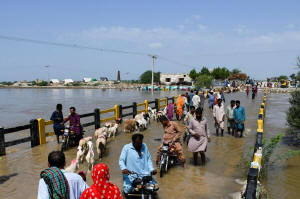Pakistan urged to open up India route to flood aid
 Send a link to a friend
Send a link to a friend
 [August 31, 2022]
By Syed Raza Hassan and Asif Shahzad [August 31, 2022]
By Syed Raza Hassan and Asif Shahzad
SHIKARPUR, Pakistan (Reuters) -
International aid agencies struggling to help hundreds of thousands of
people displaced by deadly floods in Pakistan have asked for the easing
of curbs on imports of food from Pakistan's old rival India, a Pakistani
minister said on Wednesday.
Unusually heavy monsoon rains have triggered floods that have submerged
a third of the country and killed more than 1,100 people, including 380
children. The United Nations has appealed for $160 million to help with
what it termed as an "unprecedented climate catastrophe".
Pakistan faces surging food prices, compounding the misery for the
millions affected by the disaster.
Finance Minister Miftah Ismail said the government was considering
loosening restrictions on the largely closed border with India to let in
supplies of vegetables and other food.
"More than one international agency has approached the government to
allow them to bring food items from India through the land border,"
Ismail said on Twitter.
He said the government will decide whether to allow that based on supply
conditions and after consulting its coalition partners and key
stakeholders.
Prime Minister Shehbaz Sharif said that hundreds of thousands acres of
crops have been washed away.

"We have lost rice crop. Fruits and vegetables have been destroyed," he
told reporters after his trip to the flooded areas in the north.
General Akhtar Nawaz, chief of the national disaster agency,
has said more than two million acres (809,371 hectares) of
agricultural land were flooded.
The nuclear-armed neighbours have fought three wars since they were
carved out of British India in 1947 and their border is heavily
fortified and largely sealed off.
Very little trade and travel takes place between Muslim Pakistan and
predominantly Hindu India despite historic, cultural and family ties.
[to top of second column]
|

People cross a bridge amid flood waters,
following rains and floods during the monsoon season in Puran Dhoro,
Badin, Pakistan August 30, 2022. REUTERS/Yasir Rajput

REFUGE ON ROADS
Pakistan has received nearly 190% more rain than the 30-year average
in the quarter through August this year, totalling 390.7 millimetres
(15.38 inches). Sindh province in the south, with a population of 50
million, was hardest hit, getting 466% more rain than the 30-year
average.
Resulting flash floods have swept away homes, businesses,
infrastructure and crops. The government says 33 million people, or
15% of the 220 million-strong South Asian nation, have been
affected.
Army helicopters have been busy plucking stranded families from
rooftops and patches of dry land and dropping food in inaccessible
areas.
Colossal volumes of water are pouring into the Indus river, which
cuts through the country from its northern peaks to southern plains,
spilling out along its length and leaving vast tracks of land
submerged.
Villager Fayyaz Ali, 27, in hard-hit Shikarpur district of Sindh
province, has managed to get his family to safety but has little
hope of saving his small home surrounded by flood waters.
"The house is going to fall at any moment. It's inundated," Ali told
Reuters.
Like many villagers, Ali said he had yet to receive any help.
Main roads raised above the fields have become a refuge where people
with their bundles of belongings and farm animals seek shelter from
the sun and rain under plastic.
Early estimates have put the flood damage at more than $10 billion,
the government has said, appealing to the world to help it deal with
it has called a man-made climate catastrophe.
(Additional reporting and writing by Asif Shahzad in Islamabad;
Editing by Robert Birsel and Tomasz Janowski)
[© 2022 Thomson Reuters. All rights
reserved.]
This material may not be published,
broadcast, rewritten or redistributed.
Thompson Reuters is solely responsible for this content.
 |